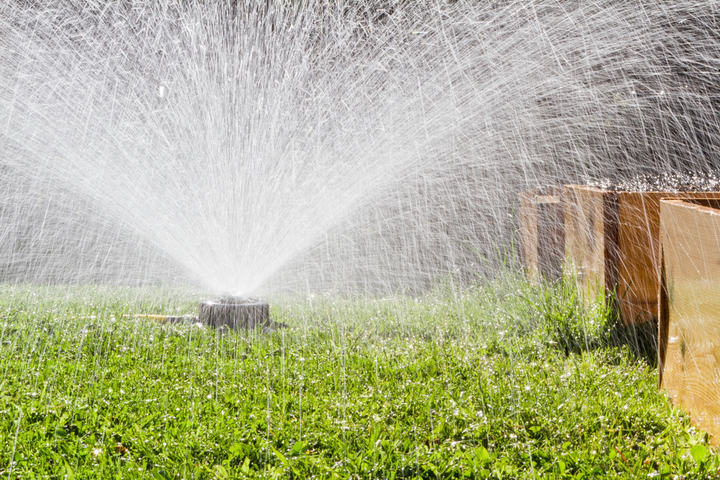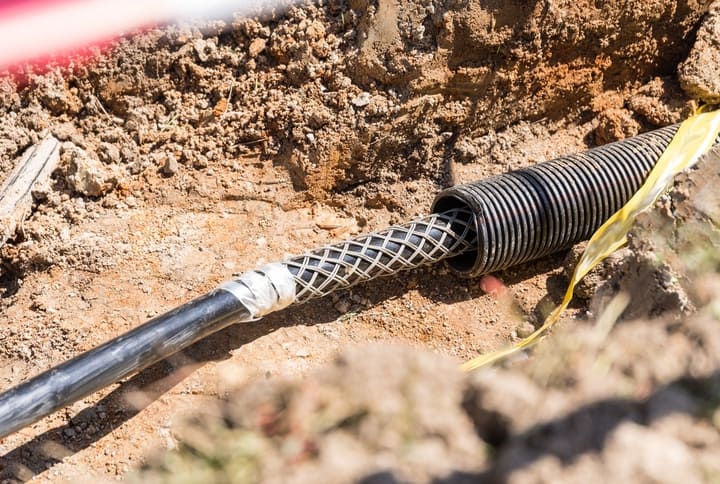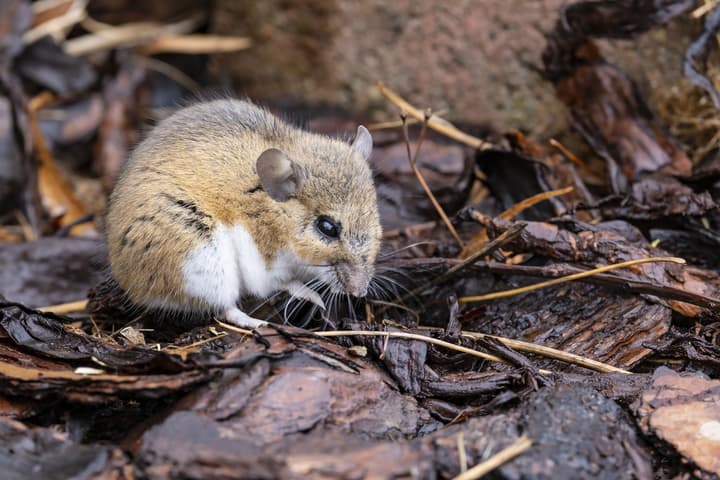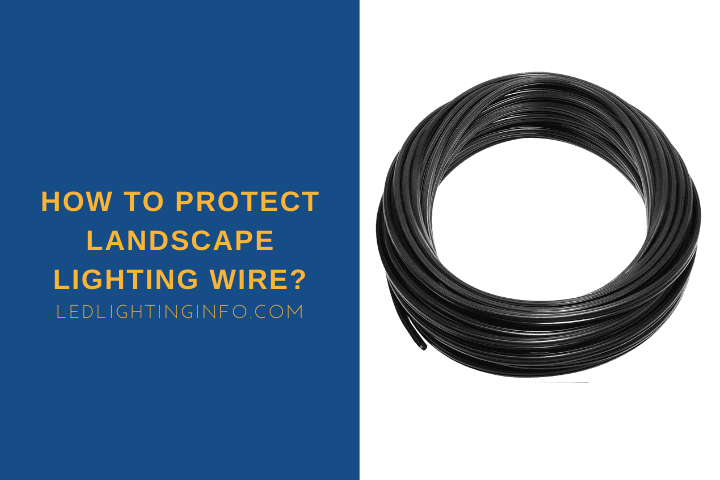Installing landscape lighting can be a project, but the results are usually worthwhile.
You can completely transform an outdoor space with some carefully chosen lights, justifying all the work you put into the installation.
But because you’ve worked so hard and probably paid a pretty penny to get the best setup you could, the last thing you want is for something to damage the wires.
Especially as it can often be hard to identify where the problem is.
You need to make sure your wire is fully waterproof, including any splices – these are the most vulnerable parts of a circuit. Consider soft insulation sleeves for your above-ground cables to prevent rodents from damaging them, and bury underground cables at least 6 inches deep.
There’s a little more to each of those, so let’s dive deeper on:
- How to waterproof your landscaping cables
- How to stop rodents from chewing through cables
- How to bury lighting cables safely
How To Waterproof Landscape Lighting Wire?

You don’t need me to tell you that the outdoors can sometimes get wet, or water and electricity aren’t perfect partners.
So, choosing the right kind of wire and connectors is vital to protecting the integrity of the circuit.
There are three different types of wire you could use.
Outdoor cable
Outdoor cable is wiring rated as safe to use outdoors but above ground.
It will be resistant to moisture and will use insulation materials also designed to withstand damage from UV rays.
It’ll work well in high and low temperatures without being damaged and is tough enough to withstand some physical damage from the elements too.
Underground burial cable
These cables are designed to be used underground, but you can’t bury them directly. Instead, you’ll need to use a conduit.
These wires are waterproofed already but they aren’t tough enough to withstand the moisture levels or the pressure of the soil, so they need that protective housing.
Direct burial cable

Cables that are rated as suitable for direct burial must withstand high levels of moisture and pressure, passing various water absorption and crush-resistance tests.
In case they come into contact with rocks under the ground, they’re extremely tough and are the safest option for underground wiring.
Of the above, you can choose the best option for your project.
If you plan to bury the wire, it’s much easier to stretch your budget slightly and go for a direct burial cable since you don’t need an extra conduit.
While it’s pretty straightforward to buy the waterproof wire already, there is one more consideration.
When connecting that wire to your lighting, how do you ensure the connectors are also waterproof?
Think of the wire connectors as a weak spot in your waterproofing. As soon as any moisture finds its way into a connector, it’s in the circuit.
There are various suitable outdoor wire connectors to preserve the circuit.
The best are pre-filled with a sealant (Amazon), often made from silicone, which completely prevents moisture from getting in.
Avoid using the connectors that pierce the wire.
While they claim to be waterproof, they’re not quite as secure due to the pierced hole often covered with tape, which isn’t as durable as a sealant.
And one last tip – when you’ve used wire connectors, add a little electrical tape to the joined wires, around 2 inches from the connector.
In the future, if anything pulls on one of the wires, the stress will be on the electrical tape rather than the connector.
This’ll prevent the wires from being pulled free.
How To Protect Underground Wire From Rodents

Once you’ve protected your cables from the elements, it’s time to consider the next major natural challenge your garden might present – fauna.
While many outdoor wires profess to be covered with a thick coating that protects against nature, in reality, rodents (and their sharp teeth) can still get through many wire covers.
And when they do, you’ll likely end up with a compromised circuit that’s no longer waterproof, potentially a break in the wire altogether, and sometimes a dead animal to dispose of.
Where the wires are not buried, you should cover them in an extra layer of insulation if you have concerns about rodents like mice, rats, or squirrels.
But you don’t need to jump straight to expensive metal braided cable protectors.
See, rodents aren’t chewing your cables because they think the wiring is a tasty snack. Instead, they’re doing it to keep their ever-growing teeth ground down and safe.
It’s the same reason cats like to scratch with their claws – it’s all about grinding down the excess.
So, by using PVC or a soft insulation layer around any above-ground parts of your wiring, rodents won’t sit there chewing. They’ll realize it’s ineffective and move on.
You can buy repellent sprays that you could spray on your wiring, or there are lots of DIY options online that involve peppermint or chili peppers, but they don’t last.
Spraying or coating your wires every couple of days is no fun!
Also, avoid buying sonic repellent tools.
They don’t tend to be effective, as the sound waves are absorbed by anything that gets in the way.
And outdoors, a lot of garden debris or wind can impact the waves. Eventually rodents get used to the sonic waves too.
How To Safely Bury Landscape Lighting Wiring

The last thing you need to worry about when protecting outdoor wire is yourself (or maybe others in your family or future owners of your home).
The problem with outdoor wiring that’s buried is that it’s not visible, so it’s easy to forget about it.
If in 12 months you decide you want a new flower bed, you don’t want to slice through the cable with a shovel.
The National Electrical Code (NEC) dictates that low voltage wire up to 30 volts (the typical type used for landscape lighting) must be buried at least 6 inches deep.
An easy hack to make this easy is to measure a distance of around 7 to 8 inches on your shovel and make a mark that won’t disappear as soon as you start digging. A painted line is a good idea.
Then, you can safely and easily dig to that level without having to constantly measure the depth of the trench.
If you live in the US, you can also call a special hotline before you start digging up your garden.
This helps you ensure there are no hidden utilities that you might accidentally cut into.
Most of these will be buried deeper than 6 inches but if you plan to dig a little lower it’s the safest option. Find out more here.
Suppose you plan to bury your outdoor wires a little deeper than 6 inches. In that case, it’s recommended you lay warning tape (Amazon) a few inches above the wire.
This is a tape made from high-visibility polyethylene, which won’t deteriorate underground.
That way, if you do forget it’s there, or the next owners of the home aren’t aware, the tape will serve as a warning not to dig any deeper without checking.
And one final reminder, if you’re burying your cable, make sure it’s either rated as direct burial or you’re using underground cable in a suitable conduit to protect it from the moist earth.
Related: How To Install Landscape Lighting Under Sidewalk?
Final Words
There is a lot to consider to ensure your outdoor lighting circuit is protected, both from the elements and any mishaps when gardening.
Follow these tips, though, and you should be able to enjoy all the fruits of your labor with a pleasantly lit garden for years to come.
Have you had any problems protecting your cables from threats I’ve not mentioned?
Any other DIY solutions of your own?

